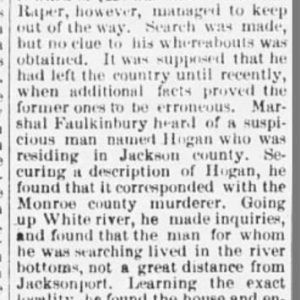calsfoundation@cals.org
Henry Owens (Reported Lynching of)
Historian George C. Wright wrote in his 1990 book Racial Violence in Kentucky, 1865–1940: Lynchings, Mob Rule, and “Legal Lynchings”: “Because Afro-Americans were frequently lynched in a dramatic fashion to warn others, it is possible that much more is known about their deaths than about those of the whites who died at the hands of lynch mobs.” Such seems to be the case with the 1879 lynching of Henry Owens in Clarendon (Monroe County), which was reported in the Arkansas Gazette only at the bottom of another article describing the likelihood of a different person being lynched.
On September 28, 1879, the Gazette reported that a man named Jerry Raper, “a murderer whose deed of cold blood has rarely been equaled in the boiling of the criminal cauldron,” had just been captured by a Newport (Jackson County) marshal and returned to Clarendon. In March, Raper had reportedly “committed a crime, an account of which would bring a blush to the Police Gazette,” a national weekly paper with sensational journalism. This crime was witnessed by George Laman, “an honest farmer” who “spoke of the transaction” to others. Consequently, Raper killed Laman while the latter was “plowing in his field.” The Gazette reported that “Raper was blacked at the time of the murder”—that is, apparently wearing blackface—“and it was but an easy matter for him to wash himself and escape.” He remained at large for several months before being apprehended in late September in the White River bottoms near Jacksonport (Jackson County).
Hearing news of Raper’s imminent return to Monroe County, “a party of about one hundred men, armed and ready, awaited the arrival of the prisoner.” But Raper was successfully lodged in the jail, and the mob “made no further demonstrations than to organize.”
The last paragraph of this Gazette article reads in full: “Several weeks ago a man named Henry Owens was taken out of the Clarendon jail and hung. His crime was severely cutting a man. There is very little doubt but Raper is hanged by this time.” However, on October 7, the Gazette carried a follow-up in the “Local Paragraphs” column citing Marshal Faulkinbury, the arresting officer, in which he specifies only that he was told “that at least one hundred men would organize and take Raper out of jail.”
Of the reported lynching of Henry Owens, nothing more is said, and little can be inferred from the information at hand, save that he was apparently white, as the race of the individual lynched was regularly specified when the victim was African American.
For additional information:
“Caught in Disguise.” Arkansas Gazette, September 28, 1879, p. 8.
“Local Paragraphs.” Arkansas Gazette, October 7, 1879, p. 8.
Staff of the CALS Encyclopedia of Arkansas







Comments
No comments on this entry yet.